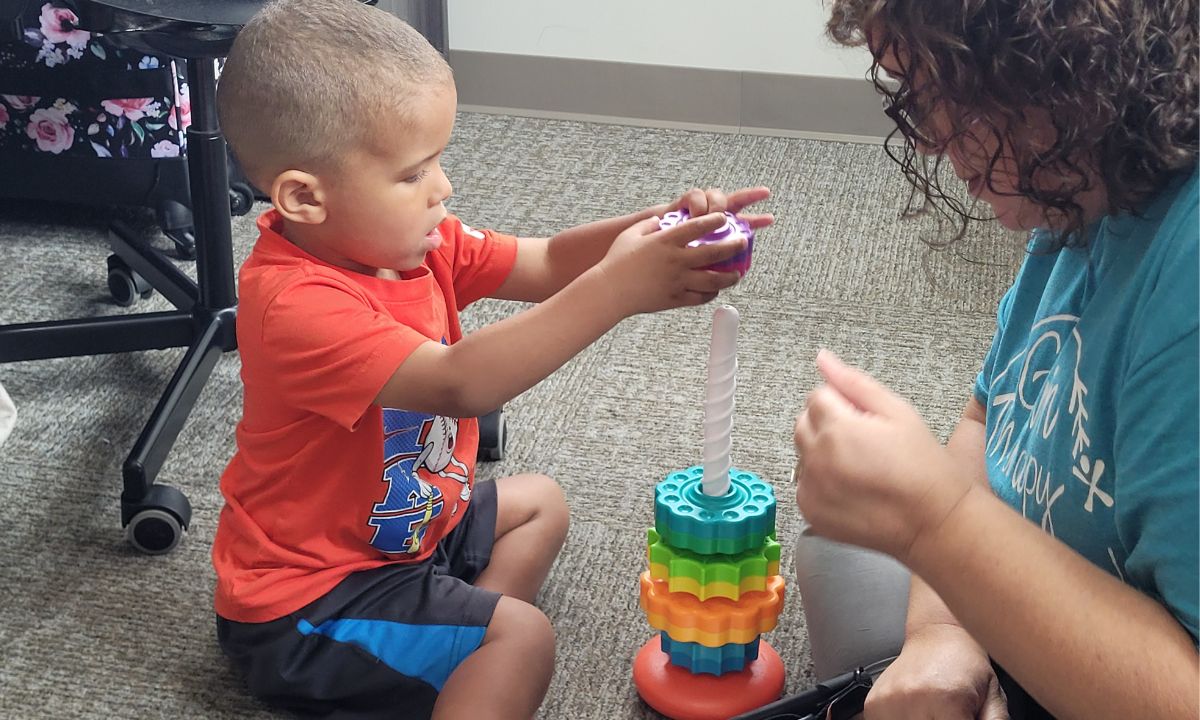Trump Medicaid Cuts Could Cost Kids Coverage That Aids Learning
Advocates worry confusion over shifting rules will make children miss out on tablets, glasses, hearing aids, and therapy that help in the classroom.

Get stories like this delivered straight to your inbox. Sign up for The 74 Newsletter
Speech therapist Anne Marie Carey sits on the rug at Galvin Therapy Center west of Cleveland, Ohio with toddler Ryin Johnson holding a tablet while she places a bright plastic ring on a rod.
“I have some more,” Carey says to the 2 1/2 year old, picking up another ring. “Should we put it on? I’m gonna do it with you.”
She takes Ryin’s hand and presses a finger to the tablet so a recorded voice says “More,” before adding the second ring to the cone.
“More!” Carey calls out. “I got more. Yay!”
This activity is more than just a game. Ryin has autism and is nonverbal, so he also receives behavioral therapy. His attention often drifts as he and Carey interact.
But the tablet, once Ryin can use it himself, is a tool that may unlock his ability to communicate and learn when he starts preschool in the fall. It might even help him eventually speak.
“Right now it’s still pretty early on,” said his mother Deanna Szente, a delivery driver from Avon Lake, Ohio. “Because he’s two and a half, we’re having high hopes, but they are preparing him… if he does not.”
Ryin’s therapies, tablet and the TouchChat program are all funded by Medicaid — and examples of how the government program, a major source of health care for low-income families, also supports children’s ability to learn and do well in school.
Medicaid also covers such school-related items as eyeglasses, hearing aids, and microphones for teachers to use to communicate with children with hearing difficulties.
Other devices and care, such as inhalers for asthma and dental coverage provided by Medicaid help make sure kids don’t miss school and add to the chronic absenteeism problems hurting kids academically.
But Medicaid faces massive cuts starting in 2027 as part of President Donald Trump’s “Big Beautiful Bill.” Cuts to Medicaid and to the accompanying Children’s Health Insurance Program (CHIP) will likely total about a trillion dollars over the next 10 years, according to estimates.
Backers of Trump’s bill say it is much-needed welfare reform that will keep people on Medicaid who really need it, while kicking off those that don’t and can work to have insurance.They also stress that students with disabilities like Ryin are not targets of the cuts.
But how the cuts will affect Ryin and other young children is still unclear: The impact will vary by state, since each has its own version of Medicaid, with different rules for eligibility and benefits, and each state contributing different amounts of money. Differences are so great that a family of four qualifies in some states earning less than $45,300 a year, while other states allow annual income of more than $96,000.
As Medicaid dollars shrink and as rules shift and grow more complicated, child advocates worry students like Ryin are more likely to slip through the cracks and miss out on interventions that are crucial to their ability to learn. They also worry the Trump administration’s removal of some backstops that keep kids on Medicaid even as parents bounce on and off it create additional danger for children.
All of which filters down to how well kids can do in the classroom.
“If the cuts are coming and if kids lose services, it can be very impactful on their learning,“ said Patricia Endley, president of the National Association of School Nurses.
Georgetown University’s Center for Children and Families researchers also raised concerns about students losing coverage and medical care that helps them in school. The center pointed to multiple studies showing students read better if they qualify for Medicaid or even if parents have Medicaid coverage that reduces family stress and frees up income.
Other studies show students covered by Medicaid have higher graduation rates and adult earnings than those that go without health coverage, Georgetown officials report
Elisabeth Burak, senior fellow at the Georgetown center, worries that as rules change and grow more confusing, parents might not enroll their children or let coverage expire.
“We know that a lot of these kids will roll on and off of coverage,” Burak said.
“They might have been enrolled for a little bit of time at some point during the year, but they dropped off because the mail didn’t reach them, or there was paperwork that their parents didn’t know about, or maybe their parent might have lost coverage and that somehow the renewal paperwork didn’t get to them,” she said.
Beyond just the common-sense idea that healthier kids do better in school or life, researchers and advocates identified several tangible ways student learning could be hurt if students lose coverage:
- Kids might miss out on early screening that catches disabilities before reaching school age. While Ryin might keep Medicaid because of his disability, being eligible for Medicaid allowed him to get checkups that identified his autism and allowed him to start treatment before preschool.
Though school district preschools can catch students’ disabilities, church-based or private preschools might not. Parents may need private therapy for their children.
“We have a lot of preschoolers… who attend community preschool or no preschool, and who come to our place for help,” said Carey, Ryin’s speech therapist. “Parents notice something’s not clicking…and they come here.”
- Children might have to wait until school for vision tests and might not ever afford eyeglasses. In addition, students may not have hearing aids to absorb words and language patterns.
“They’re going to have difficulty learning those important speech sounds and strategies to be able to follow classroom conversations,” said Caroline Bergner, director of health care policy for Medicaid for the American Speech-Language-Hearing Association.
- Children may not have inhalers so they can deal with asthma in the classroom. Researchers have found asthma to be a major cause of students missing school – nearly 13 million school days a year nationally – and of students having to repeat grades.
That’s all on top of family disruptions and stress if kids keep Medicaid but parents lose it under the new rules.
Endsley also worries about students struggling if they lose dental care.
“You might say, ‘well, what does your teeth have to do with learning?’ ” she said. “Well, if you have an impacted tooth, or if you’re having tooth pain, you absolutely cannot learn… if you’re sick or if you have a chronic disease… Having access to daily medications keeps kids in school. It really is all interconnected.”
Defenders of the bill say opponents are being overly dramatic, noting that benefits for disabled children are not being directly cut. Well-publicized requirements that adults work in order to keep coverage don’t apply to parents since they don’t kick in until children turn 19. And they say the cuts make Medicaid sustainable by trimming people that don’t need it.
Others, including Cato Institute researcher Michael Cannon, argue that limiting Medicaid’s growth is necessary for the federal budget.
“When Republicans propose that Medicaid grow at 3% annually instead of 4.5%, Democrats suddenly act like cutting waste means everyone will die,” he wrote.
Even child care advocates worried about the plan can’t say which children would lose coverage or how many and when.
They instead see risks in the confusion of shifting rules that states – and parents – will have to watch carefully.
A big reason is that Medicaid eligibility isn’t the same for children and adults, so children can still keep coverage even if parents start earning more money and lose their coverage. Parents may not realize that and let their children’s coverage lapse.
Endsley, who worked as a school nurse in Maine, said parents often don’t know how to apply for Medicaid for their kids.
“They’ll say, ‘Well, yeah, I just can’t figure it out’,” she said. “So sometimes a school nurse will help them navigate through the process, or refer them to an insurance navigator. I’ve even made a home visit to help a parent who didn’t have a computer work out the forms.“
“The whole system application process can be complicated, and what I see is kids slipping through the cracks,” she said.
There are some existing safety nets to prevent kids bouncing on and off coverage: Children keep coverage for a full year each time their eligibility is approved. Eight states — Colorado, Minnesota, New Mexico, New York, North Carolina, Oregon, Pennsylvania and Washington — went further the last few years and extended that “continuous coverage” for young children until they turn 3 or 6 to create more stability.
But the Trump administration announced July 17 it would no longer let states extend coverage beyond a year.
Bruak called that decision a “kicker” on top of the cuts.
“That could really impact the stability of family and kids coverage,” she said.
Meanwhile, Szente is talking regularly with child care advocates to stay on top of changes so she can do what it takes to keep all three of her children covered.
“I’m terrified,” Szente said. “I’m scared for when my son gets older, what we’re going to have to do to be able to make sure that he can go see a doctor. And I’m scared for my older two, if I’m still going to be able to provide Medicaid for them.”
Get stories like these delivered straight to your inbox. Sign up for The 74 Newsletter

;)
